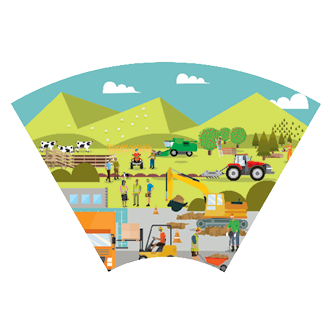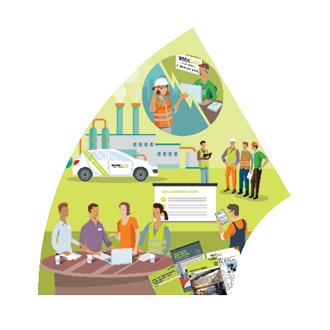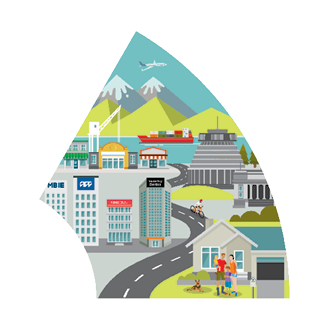Our core roles
WorkSafe’s statutory functions1 can broadly be summarised under our three core roles of harm prevention, regulatory effectiveness and system leadership.
As the regulator we promote and contribute to energy safety and the workplace health and safety system using our education, engagement and enforcement levers:

Harm prevention
- Targeting critical risks at all levels (sector and system-wide) based on evidence.
- Delivering targeted interventions (including on improving workforce capability, worker engagement and effective leadership) to address the drivers of harm.
- Influencing attitudes and behaviour to improve health and safety risk management.

Regulatory effectiveness
- Undertaking regulatory activity – educating, engaging and enforcing – to provide confidence that health and safety is appropriately managed.
- Enabling New Zealand to have confidence in WorkSafe as the primary health and safety regulator.
- Supporting confidence in the effectiveness of the health and safety regulatory regime.
System leadership
- Leading, influencing and leveraging the health and safety system to improve health and safety outcomes.
- Promoting and supporting tripartite leadership of health and safety with industry and workers.
- Leading by example through WorkSafe’s own health and safety goals.
Meeting Government expectations
The Minister for Workplace Relations and Safety has set out clear expectations of WorkSafe and we are fully committed to meeting them through our strategic work programme 2018/19, including:
Harm prevention
- A focus on work-related health.
- Strengthening worker engagement, representation and participation.
Regulatory effectiveness
- Supporting regulatory reform.
- Holding duty-holders to account.
- Enhancing the energy safety regulatory framework.
- Supporting victims and their families.
System leadership
- Work with MBIE to deliver the Health and Safety at Work Strategy.
- Commitment to a tripartite approach.
We will also strengthen our organisational capability and continue to improve our fiscal responsibility and efficiency.
Achieving our goals
Health and safety at work protects people from harm, but also contributes to the long-term wellbeing and living standards of New Zealanders. A world-class health and safety at work system enables sustainable, inclusive growth in our economy, without compromising our people and our environment.
Our context
The Treasury’s Half Year Economic and Fiscal Update 20172 sets out the current economic outlook for New Zealand. It indicates steady growth over the coming years, with falling net migration, growth in construction, and increases in labour costs and the number of people in work among the key features that are expected to affect labour market conditions. These trends also affect work-related injury rates and could also impact the social and economic cost of deaths, injuries and ill-health arising from work, which is estimated at $3.5 billion every year.
WorkSafe is committed to lifting New Zealand’s health and safety performance at work as economic activity increases, and reducing the high level of work-related harm.
While the level of harm has been reducing in recent years, it remains at an unacceptable level. There is an economic cost to this harm, but the social and emotional costs are paid by the families, friends, co-workers and communities of those who are killed, seriously injured or harmed at work.
The current targets for New Zealand include a include a 25% reduction in work-related fatalities and injuries by 2020, a 50% reduction in asbestos disease by 2040, zero catastrophic events and that fatalities from electrical and gas accidents trend down.
To meet these targets we need to work with others to collectively use our influence, insight and knowledge to embed the conditions for healthy and safe work.
The Health and Safety at Work system
Many groups influence health and safety at work, including regulators, government agencies, sector groups, practitioners, businesses, workers and unions. These groups together form our health and safety system.
WorkSafe and MBIE are jointly leading the development of the Government’s Health and Safety at Work Strategy. This Strategy will set the Government’s 10-year vision and priorities to enable a system-wide approach to transforming New Zealand’s health and safety performance. The Strategy will support greater integration amongst businesses, workers and unions in collectively driving improved performance across the health and safety system. This will save lives, save money and makes business sense.
Following the public consultation of the draft Strategy, in 2018/19 WorkSafe will contribute to the development of an action plan, working with other system participants to translate the priorities and goals of the Strategy into action.
1 WorkSafe New Zealand Act 2013, section 10
2 www.treasury.govt.nz/budget/hyefu2017/hyefu17.pdf(external link)
What we're aiming for
![]()
People value health and safety
Our work supports people to value health and safety as part of good business.
![]()
Health and safety improves wellbeing
Our work enables good health and safety to improve people's quality of life.
![]()
Collective approach to health and safety
Our work leads the health and safety system towards shared goals.
Last updated
